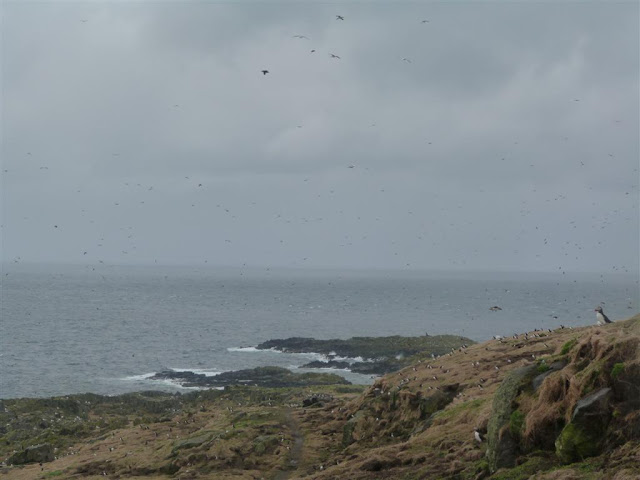I am in my 3rd season on the island but I am still stunned by the sight of a "full house", an island covered in puffins. And this isn't even all 90,000 of them as many will be underground incubating eggs. Parts of the island have puffins dotted over the whole surface and it looks like it has rained garden gnomes. But when you look beyond the spectacle you can start to see that they are actually very busy. Puffins are extremely social and so spend a lot of their time communicating when on land. It might seem that they are just standing there but given time you can see that the are they are interacting in all sorts of ways. In puffin language body language is everything. They yawn or gap their bills (an aggressive posture), they flick their heads up while fluttering their wings (done by the male to see if they females would like to mate), even just how they stand and walk means something to their neighbours. An upright posture is a burrow ownership posture that sends a message to other puffins nearby while a low-profile walk where the bird walks with its body horizontal to the ground sends a passive message and is used by birds away from their own burrow.
And why is this morning so spectacular? Well the short answer is that the experts don't really know. Puffin numbers go up and down from day to day on the island. On the Isle of May this seems to be on a 4-6 day cycle, though wind and fog seems to bring more onto the island and sunny weather means more go off. But isn't known why there is a cycle of attendance to the island in the first place. Luckily different parts of the island can be at different stages of the cycle so there are usually at least some puffins to see. But what it does mean to the visitor is that it is often those who dare win, sometimes those visitors who brave the less nice weather can see the most spectacular sights.
And here I am back at the computer and the photos can't possibly show what it looks like but I still have in my head that puffin landscape.
Stop press - at the end of the day it is still blowing and pouring and a load of exhausted, soaked migrants havge found themselves on the island. About 40 wheatears, 10 willow warblers, 10 tree pipits, 6 common redstarts, 5 pied flycatchers, a common whitethroat and a grasshopper warbler have all turned up. Exciting birding but I hope for their sakes the weather eases up tommorrow.
 |
| No way can the pictures capture the sheer number of puffins but you can see the wesather. |



No comments:
Post a Comment